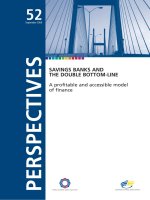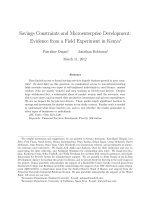BALANCED STRUCTURAL POLICY: GERMAN SAVINGS BANKS FROM A REGIONAL ECONOMIC PERSPECTIVE pptx
Bạn đang xem bản rút gọn của tài liệu. Xem và tải ngay bản đầy đủ của tài liệu tại đây (1.04 MB, 218 trang )
BALANCED STRUCTURAL POLICY:
GERMAN SAVINGS BANKS FROM A
REGIONAL ECONOMIC PERSPECTIVE
PERSPECTIVES
58
June 2009
BALANCED STRUCTURAL POLICY:
GERMAN SAVINGS BANKS FROM
A REGIONAL ECONOMIC PERSPECTIVE
Dr. Stefan Gärtner
4
This study has been published by ESBG (European Savings Banks Group)
in the framework of the Savings Banks Academic Award. The objective of
the Savings Banks Academic Award is to stimulate comparative research
projects on the rich historical heritage of the European savings banks and
to propose solutions for the future.
Dr. Stefan Gärtner won the first prize of the 2008 edition of the Award.
The findings, interpretations and conclusions expressed in this paper do
not necessarily reflect the views of ESBG (European Savings Banks Group)
or WSBI (World Savings Banks Institute). ESBG nor WSBI guarantee the
accuracy of the data included in this work. The material in this publication
is copyrighted.
Preface to the English edition
This study focuses on regional structural policy and the role played in it
by region-specific banks. An empirical analysis of the German savings
banks [Sparkassen] examines whether such banks can be successful and
their significance in regional structural policy. Without anticipating the
content of the following pages, savings banks can succeed. In fact,
they can do much more: Germany’s decentralised savings banks
contribute to the stability of the financial market.
The following is an abridged version of a doctoral thesis written between
2005 and 2007, and published in Germany in 2008. Although the study
has a regional and not a financial focus, it also found that regional banks
which check capital mobility and have long-term relationships with and
obligations to their customers stabilise financial markets. These findings
have become particularly topical in the current financial crisis, which has
confirmed their truth at least as regards Germany’s savings banks.
German savings banks have long been criticised by the European
Commission as, operating solely within set regional boundaries, they
stand for anything but the model internal market and financial market
integration. “The traditional hypothesis on the relationship between financial
integration and financial stability has been that financial integration and
globalisation would dilute risks and reinforce financial stability.”
(Commission of the European Communities 2009: 58). Since the financial
crisis began, however, there have been growing signs of a rethink:
the Commission questioned its market philosophy for the first time in
the European Financial Integration Report released in January 2009.
“The financial crisis has offered a live demonstration that financial
globalisation may indeed amplify the original financial shock.”
(Commission of the European Communities 2009: 58). In effect, the
quantitative empirical analyses presented here prove that the risks run by
Germany’s decentralised savings banks are indeed low, and when Robert
Wade (2008) from the London School of Economics suggests a suitable
response to the financial crisis is not simply better regulation but also the
creation of regional financial intermediaries focussed more on customer
care and less on profit maximisation, he is advocating something very
similar to the German savings bank system.
5
Savings banks are relatively small and have a higher concentration risk
due to their regional loan portfolios, yet are nevertheless successful and
contribute to financial market stabilisation. This can be explained by
factors such as geographical and mental proximity and a sense of
responsibility for staff and the region, in other words factors which are
disregarded in financial market theory and which cannot be recorded
using the analytical tools applied by major banks and rating agencies.
The financial crisis offers the chance to put aside traditional dogmata for
a debate on companies’ social and regional responsibility, on the role of
a State which stimulates and supports but also regulates, and on the
importance of regional diversity in Europe. The world of science as well
as political and social groups should exploit this window of opportunity.
In the context of this debate, savings banks could provide inspiration both
for European regional development and for the architecture of stable
financial markets.
Acknowledgements: Many people contributed to this study. They are
listed below in alphabetical order, without their titles or the institutions
to which they belong: Hermann Bömer, Heinz Brödner, Dorothee Chini,
Jan Fasselt, Hartmut Forndran, Julia Finke, Dagmar Grote Westrick,
Christoph van Gemmeren, Gerd Hennings, Klaus R. Kunzmann, Klaus
Krummrich, Nancy Lockkamper, Wiebke Lang, Christian Meier, Chris De
Noose, Carmen Oehler, Dieter Rehfeld, Jörg Siegmann, Eleanor Small,
Judith Terstriep, Thorsten Wehber, Marco Zieger.
I would also like to thank the experts interviewed as part of this study,
those I spoke to from the Sparkassen Darmstadt, Dortmund, Biberach
and Altmark West and the representatives of the four participating cities
and districts (a list of names can be found in the appendix).
6
7
BALANCED STRUCTURAL POLICY:
GERMAN SAVINGS BANKS FROM
A REGIONAL ECONOMIC PERSPECTIVE
Table of Contents
Preface to the English edition 5
Part A - Introduction 13
Part B - Regions and Banks: Theories, Policies and
Effects on the Area 21
1. Spatial Economic and Banking Theories 25
1.1. Competence-based Approaches in Regional Economics 28
1.1.1. Innovative Milieus 30
1.1.2. Production Clusters in a Regional Context 32
1.2. Trends in Spatial Economic Theory 35
1.2.1. Supply-oriented Theory: from Neoclassical to
New Growth Theory 35
1.2.2. Demand-Oriented Growth Theories 37
1.2.3. From Polarisation Theory to
the Growth Pole Concept 39
1.2.4. Endogenous Regional Development 42
1.3. Banks and Regions 44
1.3.1. The Function of Financial Intermediaries 45
1.3.2. Banking Theory 46
1.3.3. Banks and Regional Development 48
1.3.4. Banks and Social Capital 52
1.4. Spatial Economic Theories, Intervention and
the Role of Banks 54
2. Regional Structural and Cohesion Policy 61
2.1. Regional Structural Policy: Growth versus Equalisation 64
2.2. The Effects of Competence-Based Structural Policy 66
2.3. Levels and Stakeholders: A Focus on Savings Banks 68
8
Part C - Savings Banks: Structure, Function
and Market Position 73
3. Savings Banks and their Role on the Banking Market 75
3.1. Public Service Obligation and the Principle of Regionalism 77
3.2. The Structure of the Sparkassen-Finanzgruppe:
The Business Model 79
3.3. The Benefits of Savings Banks 81
3.4. The Role of Savings Banks on the Banking Market 82
3.4.1. The Structure of the Banking Market in Germany 82
3.4.2. Profitability and Trends 87
4. Savings Banks from a Competition, Regional Economic and
Banking Theory Perspective 91
4.1. Banking Services: Essential Public Services 92
4.2. Savings Banks in Regional Structural Policy 93
4.3. Savings Banks from a Banking Perspective 95
4.4. Conclusions from a Competition, Regional Economic
and Banking Theory Perspective 102
5. The Principle of Regionalism: The Disadvantages of Regional Ties 105
5.1. Lock-In: The Profitability of Regional Banks in Weak Regions 107
5.2. Analysis of Research to Date 108
Part D - Savings Banks and Regions: Empirics and
Regional Studies 113
6. Savings Banks’ Regional Environment and Returns 115
6.1. Quantitative Results 118
6.2. Interpreting the Findings 122
6.3. Do Savings Banks in Weak Regions Provide Adequate
Access to Credit? 124
6.4. Conclusion 126
7. Regions and their Saving Banks: A Comparative Analysis 127
7.1. The City of Darmstadt 131
7.1.1. The Economy, Employment and Potential 132
7.1.2. Economic Development Strategy/
Institutional Involvement 134
7.1.3. Sparkasse Darmstadt (Darmstadt Savings Bank) 135
7.1.4. Findings 139
9
7.2. The City of Dortmund 141
7.2.1. The Economy, Employment and Potential 142
7.2.2. Economic Development Strategy/
Institutional Involvement 144
7.2.3.
Stadtsparkasse Dortmund [Dortmund Savings Bank]
145
7.2.4. Findings 149
7.3. The District of Biberach 151
7.3.1. The Economy, Employment and Potential 152
7.3.2. Economic Development Strategy/
Institutional Involvement 153
7.3.3. Kreissparkasse Biberach
[Biberach District Savings Bank] 154
7.3.4. Findings 158
7.4. Altmarkkreis Salzwedel District 160
7.4.1. The Economy, Employment and Potential 161
7.4.2. Economic Development Strategy/
Institutional Involvement 163
7.4.3. Sparkasse Altmark West
[Altmark West Savings Bank] 164
7.4.4. Findings 167
7.5. Four Savings Banks and Four Regions: Conclusions 169
Part E - The Challenges of a Balanced Structural Policy 173
8. Savings Banks as Stakeholders in a Balanced Structural Policy 175
8.1. Balanced Structural Policy 178
8.1.1. A Common Focus Across the Spatial Hierarchy 178
8.1.2. New Spatial Models 179
8.1.3. New Spaces of Perception and Action 181
8.1.4. Flexible Public Service Provision 182
8.2. Savings Banks as Stakeholders in a Balanced Structural Policy 183
9. Conclusions 189
Part F - Appendix 193
1. List of works cited 195
1.1. Bibliography 195
1.2. Internet 209
1.3. Interviews 209
1.4. Data 211
1.5. Structural Data on Four Regions and Savings Banks (Chap. 7) 212
List of figures
Figure 1 Study outline 19
Figure 2 Competence-based approaches and
spatial economic trends 26
Figure 3 Elements and functions of local milieus 31
Figure 4 The concept of the region between economic base
theory and the cluster concept 38
Figure 5 Banking systems and space 49
Figure 6 Regional structural policy aims and strategy 62
Figure 7 Spatial economic policy: implementation levels 69
Figure 8 The Structure of the Sparkassen-Finanzgruppe (2004) 80
Figure 9 Consolidation of the German Banking Market
1995-2004 83
Figure 10 Branch numbers 1995-2004 84
Figure 11 Head of population per bank branch in 2003 85
Figure 12 Information asymmetries in the banking industry 95
Figure 13 Herfindahl-Hirschman Index 2003 for selected
EU countries 96
Figure 14 Geographical overlap between savings banks’
business areas and administrative regions 116
Figure 15 Savings bank returns and the regional economic
situation in all savings bank areas in Germany
(1999-2003) 118
Figure 16 Relationships on the regional banking market:
effects, social capital and regional market power 122
Figure 17 Matrix positioning the four sample regions 128
Figure 18 Geographical location of the four sample regions 129
Figure 19 The City of Darmstadt 131
Figure 20 The City of Dortmund 141
Figure 21 The District of Biberach 151
Figure 22 Altmarkkreis Salzwedel District 160
Figure 23 Balanced structural policy: the growth aspect 177
Figure 24 Balanced structural policy: levels involved
in implementation 178
Figure 25 Spatial scope 182
10
List of Tables
Table 1 Spatial economic theories, effects and
the role of banks 54
Table 2 Savings banks from a national, regional and
overall economic perspective 98
Table 3 Correlation coefficients (Spearman) between savings
banks and regional indicators for Germany as a whole,
western Germany and eastern Germany 119
Table 4 Savings bank lending from 1999 to 2003 Germany,
western Germany and eastern Germany 124
Table 5 Correlation coefficients between lending, the regional
indicator and population density 125
Table 6 Regional and prosperity indicators for
the regions studied 130
11
12
List of abbreviations
UR Unemployment Rate
BBR German Federal Office for Building and Regional Planning
GDP Gross Domestic Product
CIR Cost/Income Ratio
DBB Deutsche Bundesbank [German Central Bank]
ATA Average Total Assets
DSGV Deutscher Sparkassen- und Giroverband [German Savings
Bank Association]
ROE Return on Equity
GATS General Agreement on Trade in Services
Helaba Landesbank Hessen-Thüringen [regional federal state bank]
IGZ Innovations- und Gründerzentrum [Innovation Centre]
IT Information Technology
IMF International Monetary Fund
SME Small and Medium-Sized Enterprises
NEG New Economic Geography
OSGV Ostdeutscher Sparkassen- und Giroverband
[Eastern German Savings Bank Association]
ReDev. Regional Development Indicator
Indicator
ROG Raumordnungsgesetz [Regional Planning Act]
SVC SparkassenVentureCapital Dortmund GmbH
WTO World Trade Organisation
PART A - INTRODUCTION
13
14
INTRODUCTION
Unequal regional and local development within a national economy or
union of states creates regional economic disparities. In the twentieth
century, rural areas were traditionally seen as structurally weak and
were
the focus of regional equalisation measures. Now, however, spatial
disparities
are more complex; it is no longer possible to determine a clear
pattern of urban areas as winners and rural or peripheral areas as losers.
Space, perceived quality of life, images and the economic infrastructure
all determine regions’ regional economic prosperity on both sides of the
urban-rural divide. Some agglomerations, especially old industrial areas,
are now weaker than rural peripheral areas and even prosperous cities
have individual districts which have no share in economic and social
development in the city as whole.
In the past, State regional structural policy tried to boost local
development by encouraging companies to move into weak areas.
Persistently low economic growth rates, an ageing and declining
population, little to no business potential, the particular challenges posed
by German reunification and increasing international economic
integration now call for a major shift in structural policy. Structural policy
players at all levels are discussing approaches such as “cluster” or
“competence field” policy to work more on fostering existing local
competences (Beetz 2006: 15, Perlik/Messerli 2001), in particular for
eastern Germany (e.g. Dohnanyi, 2004). A more growth-focussed structural
policy is designed to develop growth potential important to the national
economy as a whole. Relevant structural political potential is not determined
solely from a regional perspective; the policy also considers competitive
global economic growth poles. This means that while all regions offer
some potential, the relevant competences are largely to be found in
the prosperous regions.
15
Although the general hope is that growth potential developed in central
areas will spill over to weaker regions, such a policy change will in fact
most likely put weaker regions at an initial disadvantage.
1
This conflict
between growth and equalisation objectives exists not only in Germany,
but increasingly also – as a result of the Lisbon Agenda – in the European
Union as a whole (e.g. Hahne 2005: 257).
Such a policy shift could initiate growth processes in overall economic
terms; however there is a danger that the absence of those regions no
longer funded will be strongly felt in any future spatial innovation system.
It must also be noted here that ex ante assessments of regions' development
are in any case extremely difficult. There is thus a danger that support be
cut off from some regions which would otherwise have had the potential
to drive their own economic development in future, and the risks of
socio-political rejection with the costs it brings for the economy as a
whole are extremely high.
A logical response to this situation is a structural-political concept aimed
at both growth and equalisation; in other words, a concept which both
supports growth potential of national economic importance and puts in place
targeted development measures for weak areas; a concept which attempts
to prevent cumulative cycles. Such a structural policy must be able to meet
differing regional requirements and, as national politicians cannot create
such a policy on their own, there is a need for regional stakeholders who
are ready and able to work on location development on the ground.
Germany’s decentralised savings bank system can play a key role here.
Savings banks are based in every region, regionally independent, bound
to the region and can only lend money deposited with them in the region
in which they operate (the principle of regionalism). They thus prevent an
outflow of capital into prosperous regions. This study will address the
question of whether these public regional banks could help develop
growth potential whilst promoting equalisation, a question which has to
date been more or less disregarded – despite the fact that banks play a
key role in regions’ economic development and insufficient access to the
credit markets can block regional development. Companies cannot develop
properly in structurally weak regions if there is a lack of banks. This in
turn means banks are less interested in these regions and the economic
gap between weak areas and the economic centres widens even further.
16
1 The question of whether or not the growth effects from prosperous regions spread to
structurally weak areas was already discussed as part of polarisation theory (Myrdal 1969)
from the 1960s to the 1980s (Dybe 2003: 15).
Yet even when there are banks in all regions, as the savings bank system
guarantees, the institutions can only contribute to regional equalisation if
they are able to generate similar returns in structurally weak regions as
they do in prosperous ones. In view of the principle of regionalism which
prevents savings banks from operating outside their own geographical
business area, this condition appears unlikely to be met.
2
It seems obvious
– upon initial consideration at least – that savings banks will generate lower
returns in weak peripheral regions, hence provide less support for regional
development and possibly even exacerbate the regional prosperity gap.
This study is based on the debate surrounding the consequences of a
more growth-focussed structural policy and how to create a structural-
political concept with both growth and equalisation aspects in line with
specific regional strengths and weaknesses. Savings banks are examined
within this framework as important structural-political stakeholders.
Cooperative banks have a similar function and structure to savings banks
but this study has focussed on the latter for the following reasons:
firstly, German savings banks are public organisations; the State has at
least indirect power and there is therefore some question about their
legitimacy from a structural-political perspective. Secondly, savings banks
as public institutions are under constant attack from private banks and
the EU Competition Commission; the question of their use is therefore of
particular significance. Thirdly and lastly, savings banks have – with very
few exceptions, where the local Landesbank [regional federal state bank]
has taken on the savings bank’s function – relatively large shares of the
market in all regions of Germany. This is in contrast to the cooperative
banks which are strongest in rural western Germany.
The situation outlined above raises the following key questions on which
this study is based:
Question 1: What effects do changes in regional science and structural-
political approaches have on the region and what role could regional
banks play as implementers of a balanced structural policy?
In response to this question, relevant spatial economic and banking
theories will be discussed and compared in Part B of this study. This will
form the basis for an analysis of the effects of new structural policy and
an examination of savings banks as local players.
17
2 This is in view of the fact that there is no savings bank equalisation fund and that savings
banks can only use their own regional business potential.
18
Question 2: What is the function of savings banks in terms of
competition, banking and the regional economy?
Part C describes savings banks in their role as structural-political players,
analyses banking structures and discusses the effects of public regional banks
on competition, banking and the regional economy. Possible disadvantages
of savings banks’ regional ties are also examined.
Question 3: What form does savings banks’ structural-political
commitment take on the ground? Are savings banks also able to
contribute to regional development in weak regions?
Part D of this study contains the key empirical analyses, examining first
the link between regions’ economic status and the returns generated
by savings banks. All approx. 470 savings bank areas are examined to
establish the correlations between high savings bank returns and regions’
economic strength. Implementation of structural policy on the ground is
also analysed on the basis of a qualitative examination of four regions
and the savings banks which operate in them.
Question 4: What form should a structural policy aimed at growth
and equalisation take and how can such a policy be supported by
the savings banks?
The final section, Part E, outlines how a balanced structural policy could
be created and supported by the savings banks.
The content and structure of the study are presented in Figure 1.
The contextual structure of the study is as follows: Part B sets out the
basis for what follows by outlining theories and spatial factors. Part C has
a descriptive and analytical function, presenting the specific structure,
significance and role of savings banks for the banking market and
regional development. Part D forms the empirical basis of the study
and presents both quantitative analyses covering all savings banks and
four regional studies. The closing section, Part E, proposes a possible
conceptual model.
Figure 1: Study outline
As regards methodology, the study is based on an evaluation of specialist
literature and interviews with experts, an analysis of selected regions and
savings banks and empirical statistical processes used to develop specific
indicators.
19
A Introduction
B Area and Banks: Theories, Policies and Effects on the Area
1. Spatial Economic and Banking Theories
2. Structural Policy, Effects and Players
C Savings Banks: Structure, Function and Market Position
3. Savings Banks and their Role on the Banking Market
4. Savings Banks from a Competition, Regional Economic and
Banking Theory Perspective
5. The Principle of Regionalism: The Disadvantages of Regional Ties
D Savings Banks and the Region: Empirics and Regional Studies
6. Savings Banks’ Spatial Environment and Returns
7. Regions and their Savings Banks
E The Challenges of a Balanced Structural Policy
8. Savings Banks as Players in a Balanced Structural Policy
9. Conclusion
Part A: Introduction
Part B: Theories and Factors Part C: Description and Analysis
Part D:
Empirics and
Regional
Studies
Part E: Conclusion and Concept
tt
20
PART B - REGIONS AND BANKS:
THEORIES, POLICIES AND EFFECTS
ON THE AREA
21
22
Regions and Banks: Theories, Policies and Effects
on the Area
Structural policy in Germany traditionally focussed on attracting new
companies and businesses. It was in the past chiefly concerned with
peripheral rural areas but has undergone fundamental changes since the
1970s with the introduction of approaches such as regionalised structural
policy and endogenous regional development. In many federal states,
policy now increasingly takes account of locally available potential.
This has not signalled the end of traditional structural policy, however,
but rather the use of supplementary or parallel approaches. A further
change in direction began around a decade ago: as part of cluster or
competence field approaches, experts are currently debating concentrating
competitive potential at a national or supraregional level albeit in the light
of locally available potential.
Competitive potential is not, however, equally distributed and is less
concentrated in structurally weak areas. Neither the academic nor the
political debate has addressed the consequences such a new structural-
political approach would have for structurally weak areas (Hübler 2005:
57, Rehfeld 1999: 247), this despite the fact that the growth pole debate
in polarisation theory (Myrdal 1969) from the 1950s to the 1980s would
provide a useful starting point. The question then as now is whether the
results of such a structural political shift would sharpen or balance out
the economic differences (Dybe 2003: 15).
In structural-political terms, the development of potential on the ground
is the very area where regional banks and the regional availability of credit
play a key role. A lack of regional financial intermediaries can lead to a
shortage of credit: banks in the centres do not have enough information
on potential borrowers in the periphery, or assume that loan transactions
in the periphery are smaller and the sums involved therefore unprofitable.
As this hinders companies’ development, these regions are thus in turn
an unattractive business prospect for the banks. In flourishing centres, on
the other hand, banks tend to concentrate and companies here therefore
have better growth and development opportunities. This leads, at least in
theory, to spatially concentrated cumulative effects (Porteous 1999) in
which banks act as a form of catalyst.
23
It can also be assumed that banks with a regional focus not only function
as financial intermediaries but also play a role in boosting the regional
economy or implementing regional structural policy – not least as banks
tied to the region must indirectly factor regional economic development
into their business calculations (Dybe 2005: 218).
Banks and financial market systems are notwithstanding this situation
almost never discussed in terms of spatial economic theory or regional
economics. Although regional banks were implicitly considered by
MYRDAL (1959, 1969) in regional polarisation theory, CHICK and DOW’s
claim in 1988 that “the tendency in the literature is to ignore financial
factors” (1988: 219) is in essence still an apt description of current spatial
economic theory.
Part B of this study examines the effects changes in regional science and
structural-political approaches have on regions and the role regional
banks could play as implementers of a balanced structural policy.
Developments in spatial economic theory, the factors influencing spatial
structures and the effects of a competence-focussed regional structural
policy will be discussed here in the light of financial and banking market
conditions. The first chapter deals with spatial economic theories, in
particular more recent regional economic approaches, and considers the
role of banks in regional development. Chapter 2 outlines regional
structural policy, discusses its effects and examines the players involved in
implementation on the ground.
24
1. SPATIAL ECONOMIC AND
BANKING THEORIES
In the past, spatial aspects played hardly any role in economic analyses
and were considered in economic issues only in certain minor areas
of geography or urban and regional economics (Krugman 1991: 3ff.).
There was an assumption that perfect competition would lead to the
optimum distribution of resources, and that mobility in production factors
ensured balanced spatial economic development. It was therefore a long
time before the discipline of spatial economics developed. Yet what was
discovered in reality, namely that regions develop unequally, is a challenge
to experts to establish the reasons why and create development concepts
offering particular support for weaker regions.
Explanatory models and theories have not evolved solely over time and
by region Alternative approaches have been developed which in some
cases are complementary and in others diametrically opposed. To date,
no universally applicable, workable spatial economic development theory
has emerged (Schätzl 2001: 29; Axt 2000: 151). Spatial economic
growth and development theories are all, notwithstanding their range
and diversity, based on one of three basic concepts as shown below
(Gärtner 2003: 58).
25
Figure 2: Competence-based approaches and spatial economic
trends
Various different models and approaches have developed from these
basic concepts, but at the same time a change of direction is also
emerging in both structural policy and in spatial economics (termed
“competence-based approaches” in the diagram above). Key aspects of
this change are:
n the development of competence available locally;
n considering geographical space to a greater or lesser extent together
with its socio-economic impact (Läpple 1998a: 69), in other words
agglomeration effects, networks, inter-firm cooperation (Dybe 2003:
346), increasing scale effects (Krugman 1991, Fujita et al. 199),
endogenous potential (Hahne/von Stackelberg 1994) and also cultural
factors (Grote Westrick/Rehfeld 2006);
n a particular focus on knowledge spillover; there is a growing
consensus that this depends on geographical proximity (Koschatzky
2002), and
n the strategic focus on a regional competition model in which the
stakes are quality or competence.
26
Competence-based
approaches
Production clusters
Learning regions
New growth
theory models
Economic
base theory and
the concept of
endogenous
development
Centre-
periphery model/
Growth
pole concept
Further
development:
approaches
and models
s
Neoclassical
equilibrium
theories
s
Demand-based
growth theories
s
Polarisation
theory approaches
Basic concepts
of spatial
development
theory
Industrial Districts
Innovative milieus









